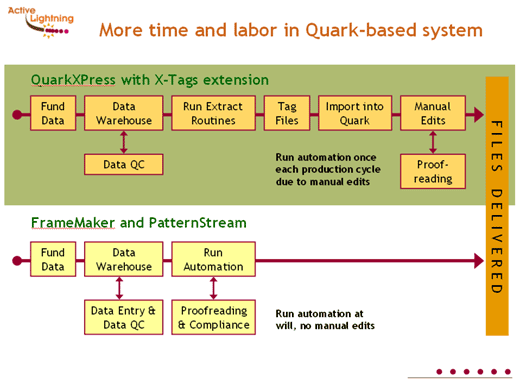Automated Publishing
100% automated production
...and stable
FrameMaker® vs. QuarkXPress®
QuarkXPress, as a valued tool for manual desktop publishing tasks, is not suitable as a component for automated desktop-publishing. What makes FrameMaker different?
Firstly, FrameMaker has hooks for automation machinery built into it. These hooks, provided through the FrameMaker Developer Kit, create a robust, stable interface for automation tasks.
Additionally, FrameMaker supports many formatting techniques that Quark does not, such as table styles, automatic numbering of lists, custom bullet styles, side-heads, and multiple flows per page. FrameMaker also supports the handling of objects such as variables, cross-references, hyperlinks, and Acrobat bookmarks.
Next, FrameMaker and QuarkXPress are targeted for unique and different publishing audiences. Each product is optimized to support its intended users. FrameMaker is optimized to support a template-driven workflow, where pages are formatted and laid out automatically through the use of a template; Quark is optimized to support a design-driven workflow, which relies on the skill and judgment of the user to place and format assets on a page.
If manually-produced pages in Quark need to be combined with automation-produced pages from FrameMaker, then they can be combined in a pdf [portable document format] file using Adobe® Acrobat®. Like industrial processes, a final published product can be composed of parts that are manufactured using automation and other parts that are manufactured by people manually.
More time and labor is involved in a workflow that attempts to utilize Quark in a semi-automated workflow, specifically because the production is not fully automated. Semi-automated workflows require more effort for: production, proofing, supervision, and project management. The following diagram shows different workflows for Quark-based automation of financial factsheets versus PatternStream/FrameMaker automation.

Desktop Publishing Staff does not need to learn FrameMaker
No one needs to interact with FrameMaker except the automation developer. FrameMaker provides the means to define and apply style definitions mechanically. The output of the process is one or more pdf, xml, or html files that are ready to go.
100% automation means less opportunities for errors which in turn reduces the need for proof-reading.
Lessons from Experience
A staff person from Database Publishing Consultants, Inc. reported that their Quark-based solutions for database publishing provide 80%-90% automation; the remainder is done manually. A person at Handy Coop (
Database publishing solutions based on FrameMaker are highly stable and capable of 100% automation for the delivery of pdf and xml files.
Industry Standard for Structured Content and Long Documents
FrameMaker is a packaged application with a large installed base. Often, when organizations work with structured content (for example content that is organized with a similar hierarchy to an outline) or when organizations need to maintain and produce long documents, they turn to FrameMaker.
The following link leads to FrameMaker success stories at the Adobe Systems web site:
http://www.adobe.com/products/framemaker/customerstories.html
